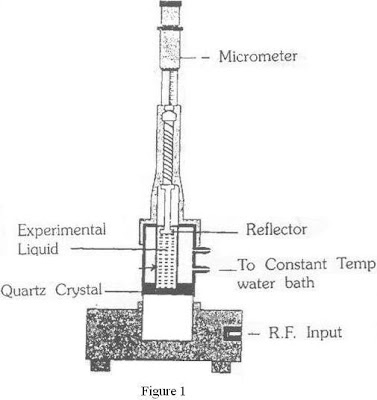AIM: To find the velocity of sound in the given liquid using ultrasonic interferometer.
APPARATUS: ultrasonic interferometer (High frequency generator and measuring cell with micrometer and quartz crystal), Experimental liquid.
PRINCIPLE: An ultrasonic interferometer is a simple and direct device to determine the ultrasonic velocity in liquids with a high degree of accuracy. The principle employed in the measurement of velocity (v) is based on the accurate determination of the wavelength (l) in the medium. Ultrasonic waves of known frequency (f) are produced by a quartz crystal fixed at the bottom of the cell. These waves are reflected by a movable metallic plate kept parallel to the quartz crystal. If the separation between these two plates is exactly a whole acoustic resonance gives rise to an electrical reaction on the generator driving the quartz crystal and the anode current of the generator becomes a maximum.
If the distance is now increased or decreased and the variation is exactly l/2 or multiple of it, anode current becomes maximum. Using the value of l, the velocity (v) can be obtained by the relation
v = l × f
APPARATUS: ultrasonic interferometer (High frequency generator and measuring cell with micrometer and quartz crystal), Experimental liquid.
PRINCIPLE: An ultrasonic interferometer is a simple and direct device to determine the ultrasonic velocity in liquids with a high degree of accuracy. The principle employed in the measurement of velocity (v) is based on the accurate determination of the wavelength (l) in the medium. Ultrasonic waves of known frequency (f) are produced by a quartz crystal fixed at the bottom of the cell. These waves are reflected by a movable metallic plate kept parallel to the quartz crystal. If the separation between these two plates is exactly a whole acoustic resonance gives rise to an electrical reaction on the generator driving the quartz crystal and the anode current of the generator becomes a maximum.
If the distance is now increased or decreased and the variation is exactly l/2 or multiple of it, anode current becomes maximum. Using the value of l, the velocity (v) can be obtained by the relation
v = l × f
PROCEDURE: Unscrew the knurled cap of the cell and lift it away from double walled construction of the cell. In the middle portion of it pour experimental liquid and screw the knurled cap. Wipe out excess liquid overflowing from the cell. Insert the cell in the socket and clamp it with the help of a screw provided on its side. High frequency generator is connected to the cell using co-axial cables. Move the micrometer slowly in either clockwise or anticlockwise direction till the anode current on the ammeter on the high frequency generator shows a maximum or a minimum. Note the readings of micrometer. Take readings of a few consecutive maximum or minimum. The difference between two consecutive readings will give l/2. Once the wavelength (l) is known the velocity of ultrasonic wave in the liquid can be calculated.
OBSERVATIONS:
To find the least count of the micrometer
Number of rotations given to the screw head (N) =
Distance covered on the pitch scale (S) =
Pitch of the screw = S/N =
Total head scale divisions =
Least count (LC) = Pitch of the screw / Total head scale divisions =
Total reading (TR) = PSR + (HSD × LC)
Order of the maximum current
Micrometer reading(R1) mm
Order of the maximum current
Micrometer reading(R2) mm
Mean l =
CALCULATIONS:
Frequency of the ultrasonic wave (f) =
Wavelength of the ultrasonic wave (l) =
Velocity of the ultrasonic waves in the given liquid (v) = l × f
RESULT:
Velocity of the ultrasonic waves in the given liquid
To find the least count of the micrometer
Number of rotations given to the screw head (N) =
Distance covered on the pitch scale (S) =
Pitch of the screw = S/N =
Total head scale divisions =
Least count (LC) = Pitch of the screw / Total head scale divisions =
Total reading (TR) = PSR + (HSD × LC)
Order of the maximum current
Micrometer reading(R1) mm
Order of the maximum current
Micrometer reading(R2) mm
Mean l =
CALCULATIONS:
Frequency of the ultrasonic wave (f) =
Wavelength of the ultrasonic wave (l) =
Velocity of the ultrasonic waves in the given liquid (v) = l × f
RESULT:
Velocity of the ultrasonic waves in the given liquid



7 comments:
theory incorrect it seems
So we utilize this property to separate substances from a liquid to a liquid. Hence, Manufacturing
Looking for Chemistry Lab Instruments Manufacturer Company in India ? Don’t worry we are the best Chemistry Lab Instruments Manufacturer, Exporter and Suppliers. For all logical lab hardware we are the significant provider from over 60 years. Call us for order.
Thanks for this post. It is Very nice Blog. I like it. Thanks for sharing knowledge. Ask you to share good Blog again.
Physics Lab Equipment
Thanks for sharing such a nice post about Physics Lab. It is quite interesting, I was seeking more details about Dynamic Kit for Physics Lab Exporter. Keep sharing this kind of informative stuff.
Amazing post!! A huge range of interested questions are here which is a good set technique to check an individual knowledge. Read more about Physics Lab Instruments Manufacturer
Helpful information, thanks for sharing with us about physics lab equipment.
Post a Comment